D-Dimer beyond Diagnosis of Pulmonary Embolism: Its Implication for Long-Term Prognosis in Cardio-Oncology Era
Abstract
1. Introduction
2. Materials and Methods
2.1. Study Design and Subjects
2.2. Data Collection
2.3. Statistical Analysis
3. Results
3.1. The Patient Characteristics at Baseline
3.2. The Severity of PE and the Primary Trigger Leading to PE Diagnosis
3.3. Initial Treatment of PE and Treatment Response
3.4. Post-Discharge Outcome
4. Discussion
4.1. CAT-PE in Contemporary Clinical Practice
4.2. Time Course Changes and Prognostic Significance of D-Dimer
4.3. Limitations
5. Conclusions
Supplementary Materials
Author Contributions
Funding
Institutional Review Board Statement
Informed Consent Statement
Data Availability Statement
Conflicts of Interest
References
- Sung, H.; Ferlay, J.; Siegel, R.L.; Laversanne, M.; Soerjomataram, I.; Jemal, A.; Bray, F. Global Cancer Statistics 2020: GLOBOCAN Estimates of Incidence and Mortality Worldwide for 36 Cancers in 185 Countries. CA Cancer J. Clin. 2021, 71, 209–249. [Google Scholar] [CrossRef] [PubMed]
- Howlader, N.; Forjaz, G.; Mooradian, M.J.; Meza, R.; Kong, C.Y.; Cronin, K.A.; Mariotto, A.B.; Lowy, D.R.; Feuer, E.J. The Effect of Advances in Lung-Cancer Treatment on Population Mortality. N. Engl. J. Med. 2020, 383, 640–649. [Google Scholar] [CrossRef] [PubMed]
- Amodio, R.; Zarcone, M.; Cusimano, R.; Campisi, I.; Dolcemascolo, C.; Traina, A.; Agostara, B.; Romano, N. Target therapy in HER2-overexpressing breast cancer patients. Omics 2011, 15, 363–367. [Google Scholar] [CrossRef] [PubMed]
- Timp, J.F.; Braekkan, S.K.; Versteeg, H.H.; Cannegieter, S.C. Epidemiology of cancer-associated venous thrombosis. Blood 2013, 122, 1712–1723. [Google Scholar] [CrossRef]
- Khorana, A.A.; Francis, C.W.; Culakova, E.; Fisher, R.I.; Kuderer, N.M.; Lyman, G.H. Thromboembolism in hospitalized neutropenic cancer patients. J. Clin. Oncol. 2006, 24, 484–490. [Google Scholar] [CrossRef]
- Walker, A.J.; Card, T.R.; West, J.; Crooks, C.; Grainge, M.J. Incidence of venous thromboembolism in patients with cancer—A cohort study using linked United Kingdom databases. Eur. J. Cancer 2013, 49, 1404–1413. [Google Scholar] [CrossRef]
- Prandoni, P.; Lensing, A.W.; Piccioli, A.; Bernardi, E.; Simioni, P.; Girolami, B.; Marchiori, A.; Sabbion, P.; Prins, M.H.; Noventa, F.; et al. Recurrent venous thromboembolism and bleeding complications during anticoagulant treatment in patients with cancer and venous thrombosis. Blood 2002, 100, 3484–3488. [Google Scholar] [CrossRef]
- Wu, M.D.; Moslehi, J.J.; Lindner, J.R. Arterial Thrombotic Complications of Tyrosine Kinase Inhibitors. Arterioscler. Thromb. Vasc. Biol. 2021, 41, 3–10. [Google Scholar] [CrossRef]
- Cushman, M.; Folsom, A.R.; Wang, L.; Aleksic, N.; Rosamond, W.D.; Tracy, R.P.; Heckbert, S.R. Fibrin fragment D-dimer and the risk of future venous thrombosis. Blood 2003, 101, 1243–1248. [Google Scholar] [CrossRef]
- Kohli, M.; Fink, L.M.; Spencer, H.J.; Zent, C.S. Advanced prostate cancer activates coagulation: A controlled study of activation markers of coagulation in ambulatory patients with localized and advanced prostate cancer. Blood Coagul. Fibrinolysis 2002, 13, 1–5. [Google Scholar] [CrossRef]
- Ay, C.; Vormittag, R.; Dunkler, D.; Simanek, R.; Chiriac, A.L.; Drach, J.; Quehenberger, P.; Wagner, O.; Zielinski, C.; Pabinger, I. D-dimer and prothrombin fragment 1 + 2 predict venous thromboembolism in patients with cancer: Results from the Vienna Cancer and Thrombosis Study. J. Clin. Oncol. 2009, 27, 4124–4129. [Google Scholar] [CrossRef] [PubMed]
- JCS Joint Working Group. Guidelines for the Diagnosis, Treatment and Prevention of Pulmonary Thromboembolism and Deep Vein Thrombosis (JCS 2017). Available online: https://www.j-circ.or.jp/cms/wp-content/uploads/2017/09/JCS2017_ito_h.pdf (accessed on 12 December 2022).
- Jaff, M.R.; McMurtry, M.S.; Archer, S.L.; Cushman, M.; Goldenberg, N.; Goldhaber, S.Z.; Jenkins, J.S.; Kline, J.A.; Michaels, A.D.; Thistlethwaite, P.; et al. Management of massive and submassive pulmonary embolism, iliofemoral deep vein thrombosis, and chronic thromboembolic pulmonary hypertension: A scientific statement from the American Heart Association. Circulation 2011, 123, 1788–1830. [Google Scholar] [CrossRef]
- Konstantinides, S.V.; Meyer, G.; Becattini, C.; Bueno, H.; Geersing, G.J.; Harjola, V.P.; Huisman, M.V.; Humbert, M.; Jennings, C.S.; Jiménez, D.; et al. 2019 ESC Guidelines for the diagnosis and management of acute pulmonary embolism developed in collaboration with the European Respiratory Society (ERS). Eur. Heart J. 2020, 41, 543–603. [Google Scholar] [CrossRef]
- Schulman, S.; Kearon, C. Definition of major bleeding in clinical investigations of antihemostatic medicinal products in non-surgical patients. J. Thromb. Haemost. 2005, 3, 692–694. [Google Scholar] [CrossRef]
- Wang, Y.; Liu, Z.H.; Zhang, H.L.; Luo, Q.; Zhao, Z.H.; Zhao, Q. Predictive value of D-dimer test for recurrent venous thromboembolism at hospital discharge in patients with acute pulmonary embolism. J. Thromb. Thrombolysis. 2011, 32, 410–416. [Google Scholar] [CrossRef] [PubMed]
- Maestre, A.; Trujillo-Santos, J.; Visoná, A.; Lobo, J.L.; Grau, E.; Malý, R.; Duce, R.; Monreal, M. D-dimer levels and 90-day outcome in patients with acute pulmonary embolism with or without cancer. Thromb Res. 2014, 133, 384–389. [Google Scholar] [CrossRef] [PubMed]
- Cohen, A.T.; Gitt, A.K.; Bauersachs, R.; Fronk, E.M.; Laeis, P.; Mismetti, P.; Monreal, M.; Willich, S.N.; Bramlage, P.; Agnelli, G.; et al. The management of acute venous thromboembolism in clinical practice. Results from the European PREFER in VTE Registry. Thromb. Haemost. 2017, 117, 1326–1337. [Google Scholar] [CrossRef]
- Yamashita, Y.; Morimoto, T.; Amano, H.; Takase, T.; Hiramori, S.; Kim, K.; Konishi, T.; Akao, M.; Kobayashi, Y.; Inoue, T.; et al. Anticoagulation Therapy for Venous Thromboembolism in the Real World-From the COMMAND VTE Registry. Circ. J. 2018, 82, 1262–1270. [Google Scholar] [CrossRef]
- Polo Friz, H.; Pezzetti, V.; Orenti, A.; Caleffi, A.; Corno, V.; Crivellari, C.; Petri, F.; Polo Friz, M.; Punzi, V.; Teruzzi, D.; et al. Comorbidity burden conditions the prognostic performance of D-dimer in elderly patients with acute pulmonary embolism. Am. J. Emerg. Med. 2019, 37, 799–804. [Google Scholar] [CrossRef]
- Haas, S.; Ageno, W.; Weitz, J.I.; Goldhaber, S.Z.; Turpie, A.G.G.; Goto, S.; Angchaisuksiri, P.; Dalsgaard Nielsen, J.; Kayani, G.; Zaghdoun, A.; et al. Anticoagulation therapy patterns for acute treatment of venous thromboembolism in GARFIELD-VTE patients. J. Thromb. Haemost. 2019, 17, 1694–1706. [Google Scholar] [CrossRef]
- Sakamoto, J.; Yamashita, Y.; Morimoto, T.; Amano, H.; Takase, T.; Hiramori, S.; Kim, K.; Oi, M.; Akao, M.; Kobayashi, Y.; et al. Cancer-Associated Venous Thromboembolism in the Real World- From the COMMAND VTE Registry. Circ. J. 2019, 83, 2271–2281. [Google Scholar] [CrossRef]
- Liu, X.; Zheng, L.; Han, J.; Song, L.; Geng, H.; Liu, Y. Joint analysis of D-dimer, N-terminal pro b-type natriuretic peptide, and cardiac troponin I on predicting acute pulmonary embolism relapse and mortality. Sci. Rep. 2021, 11, 14909. [Google Scholar] [CrossRef] [PubMed]
- Goldhaber, S.Z.; Ageno, W.; Casella, I.B.; Chee, K.H.; Schellong, S.; Singer, D.E.; Desch, M.; Reilly, P.A.; Donado, E.; Tang, W.; et al. Profile of Patients Diagnosed With Acute Venous Thromboembolism in Routine Clinical Practice: The RE-COVERY DVT/PE™ Study. Am. J. Med. 2020, 133, 936–945. [Google Scholar] [CrossRef] [PubMed]
- Prins, M.H.; Lensing, A.W.; Brighton, T.A.; Lyons, R.M.; Rehm, J.; Trajanovic, M.; Davidson, B.L.; Beyer-Westendorf, J.; Pap, Á.F.; Berkowitz, S.D.; et al. Oral rivaroxaban versus enoxaparin with vitamin K antagonist for the treatment of symptomatic venous thromboembolism in patients with cancer (EINSTEIN-DVT and EINSTEIN-PE): A pooled subgroup analysis of two randomised controlled trials. Lancet Haematol. 2014, 1, e37–e46. [Google Scholar] [CrossRef] [PubMed]
- Raskob, G.E.; van Es, N.; Verhamme, P.; Carrier, M.; Di Nisio, M.; Garcia, D.; Grosso, M.A.; Kakkar, A.K.; Kovacs, M.J.; Mercuri, M.F.; et al. Edoxaban for the Treatment of Cancer-Associated Venous Thromboembolism. N. Engl. J. Med. 2018, 378, 615–624. [Google Scholar] [CrossRef]
- Agnelli, G.; Becattini, C.; Meyer, G.; Muñoz, A.; Huisman, M.V.; Connors, J.M.; Cohen, A.; Bauersachs, R.; Brenner, B.; Torbicki, A.; et al. Apixaban for the Treatment of Venous Thromboembolism Associated with Cancer. N. Engl. J. Med. 2020, 382, 1599–1607. [Google Scholar] [CrossRef]
- Reitter, S.; Laczkovics, C.; Waldhoer, T.; Mayerhofer, M.; Vutuc, C.; Pabinger, I. Long-term survival after venous thromboembolism: A retrospective selected cohort study among young women. Haematologica 2010, 95, 1425–1428. [Google Scholar] [CrossRef] [PubMed]
- Puurunen, M.K.; Gona, P.N.; Larson, M.G.; Murabito, J.M.; Magnani, J.W.; O’Donnell, C.J. Epidemiology of venous thromboembolism in the Framingham Heart Study. Thromb Res. 2016, 145, 27–33. [Google Scholar] [CrossRef]
- Ay, C.; Dunkler, D.; Pirker, R.; Thaler, J.; Quehenberger, P.; Wagner, O.; Zielinski, C.; Pabinger, I. High D-dimer levels are associated with poor prognosis in cancer patients. Haematologica 2012, 97, 1158–1164. [Google Scholar] [CrossRef]
- Prandoni, P.; Noventa, F.; Ghirarduzzi, A.; Pengo, V.; Bernardi, E.; Pesavento, R.; Iotti, M.; Tormene, D.; Simioni, P.; Pagnan, A. The risk of recurrent venous thromboembolism after discontinuing anticoagulation in patients with acute proximal deep vein thrombosis or pulmonary embolism. A prospective cohort study in 1,626 patients. Haematologica 2007, 92, 199–205. [Google Scholar] [CrossRef]
- Khorana, A.A. Venous thromboembolism and prognosis in cancer. Thromb Res. 2010, 125, 490–493. [Google Scholar] [CrossRef] [PubMed]
- Trousseau, A. Phlegmasia Alba Dolens; Clinique Medicale de l’Hotel-Dieu de Paris: Paris, France, 1865; pp. 94–96. [Google Scholar]
- Geissenberger, F.; Schwarz, F.; Probst, M.; Haberl, S.; Gruetzner, S.; Kroencke, T.; von Scheidt, W.; Berghaus, T.M. D-Dimer Predicts Disease Severity but Not Long-Term Prognosis in Acute Pulmonary Embolism. Clin. Appl. Thromb. Hemost. 2019, 25, 1076029619863495. [Google Scholar] [CrossRef] [PubMed]
- Lobo, J.L.; Zorrilla, V.; Aizpuru, F.; Grau, E.; Jiménez, D.; Palareti, G.; Monreal, M. D-dimer levels and 15-day outcome in acute pulmonary embolism. Findings from the RIETE Registry. J. Thromb. Haemost. 2009, 7, 1795–1801. [Google Scholar] [CrossRef] [PubMed]
- Klok, F.A.; Djurabi, R.K.; Nijkeuter, M.; Eikenboom, H.C.; Leebeek, F.W.; Kramer, M.H.; Kaasjager, K.; Kamphuisen, P.W.; Büller, H.R.; Huisman, M.V. High D-dimer level is associated with increased 15-d and 3 months mortality through a more central localization of pulmonary emboli and serious comorbidity. Br. J. Haematol. 2008, 140, 218–222. [Google Scholar] [CrossRef] [PubMed]
- Grau, E.; Tenías, J.M.; Soto, M.J.; Gutierrez, M.R.; Lecumberri, R.; Pérez, J.L.; Tiberio, G. D-dimer levels correlate with mortality in patients with acute pulmonary embolism: Findings from the RIETE registry. Crit. Care Med. 2007, 35, 1937–1941. [Google Scholar] [CrossRef] [PubMed]
- Paneesha, S.; Cheyne, E.; French, K.; Bacchu, S.; Borg, A.; Rose, P. High D-dimer levels at presentation in patients with venous thromboembolism is a marker of adverse clinical outcomes. Br. J. Haematol. 2006, 135, 85–90. [Google Scholar] [CrossRef] [PubMed]
- Bajaj, A.; Rathor, P.; Sehgal, V.; Kabak, B.; Shetty, A.; Al Masalmeh, O.; Hosur, S. Prognostic Value of Biomarkers in Acute Non-massive Pulmonary Embolism: A Systematic Review and Meta-analysis. Lung 2015, 193, 639–651. [Google Scholar] [CrossRef]
- Bi, W.; Liang, S.; He, Z.; Jin, Y.; Lang, Z.; Liu, H.; Wang, Y.; Li, S. The Prognostic Value of the Serum Levels of Brain Natriuretic Peptide, Troponin I, and D-Dimer, in Addition to the Neutrophil-to-Lymphocyte Ratio, for the Disease Evaluation of Patients with Acute Pulmonary Embolism. Int. J. Gen. Med. 2021, 14, 303–308. [Google Scholar] [CrossRef]
- Browder, T.; Folkman, J.; Pirie-Shepherd, S. The hemostatic system as a regulator of angiogenesis. J. Biol. Chem. 2000, 275, 1521–1524. [Google Scholar] [CrossRef]
- Rickles, F.R.; Patierno, S.; Fernandez, P.M. Tissue factor, thrombin, and cancer. Chest 2003, 124, 58s–68s. [Google Scholar] [CrossRef]
- Palareti, G.; Cosmi, B.; Legnani, C.; Tosetto, A.; Brusi, C.; Iorio, A.; Pengo, V.; Ghirarduzzi, A.; Pattacini, C.; Testa, S.; et al. D-dimer testing to determine the duration of anticoagulation therapy. N. Engl. J. Med. 2006, 355, 1780–1789. [Google Scholar] [CrossRef] [PubMed]
- Bruinstroop, E.; Klok, F.A.; Van De Ree, M.A.; Oosterwijk, F.L.; Huisman, M.V. Elevated D-dimer levels predict recurrence in patients with idiopathic venous thromboembolism: A meta-analysis. J. Thromb. Haemost. 2009, 7, 611–618. [Google Scholar] [CrossRef] [PubMed]
- Key, N.S.; Khorana, A.A.; Kuderer, N.M.; Bohlke, K.; Lee, A.Y.Y.; Arcelus, J.I.; Wong, S.L.; Balaban, E.P.; Flowers, C.R.; Francis, C.W.; et al. Venous Thromboembolism Prophylaxis and Treatment in Patients With Cancer: ASCO Clinical Practice Guideline Update. J. Clin. Oncol. 2020, 38, 496–520. [Google Scholar] [CrossRef] [PubMed]
- Lyon, A.R.; López-Fernández, T.; Couch, L.S.; Asteggiano, R.; Aznar, M.C.; Bergler-Klein, J.; Boriani, G.; Cardinale, D.; Cordoba, R.; Cosyns, B.; et al. 2022 ESC Guidelines on cardio-oncology developed in collaboration with the European Hematology Association (EHA), the European Society for Therapeutic Radiology and Oncology (ESTRO) and the International Cardio-Oncology Society (IC-OS): Developed by the task force on cardio-oncology of the European Society of Cardiology (ESC). Europ. Heart J. 2022, 43, 4229–4361. [Google Scholar] [CrossRef]
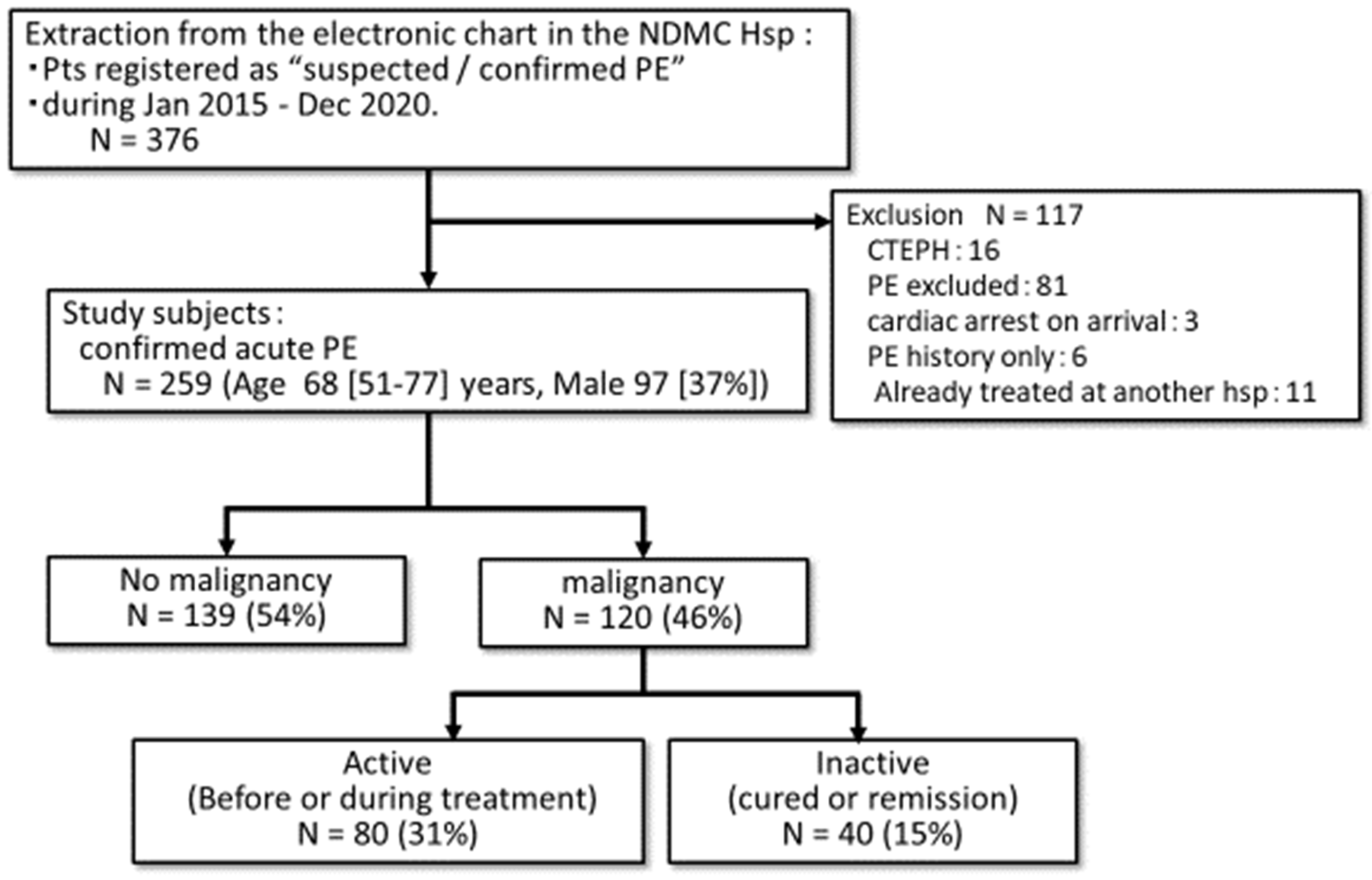
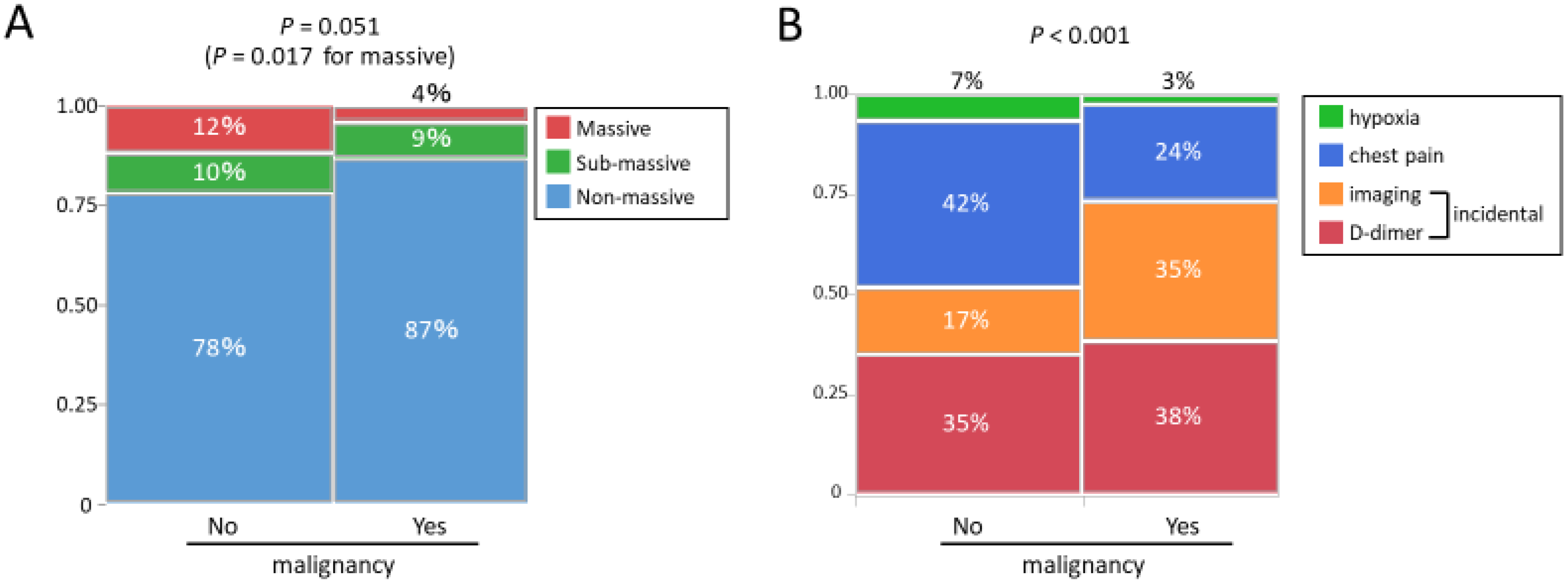
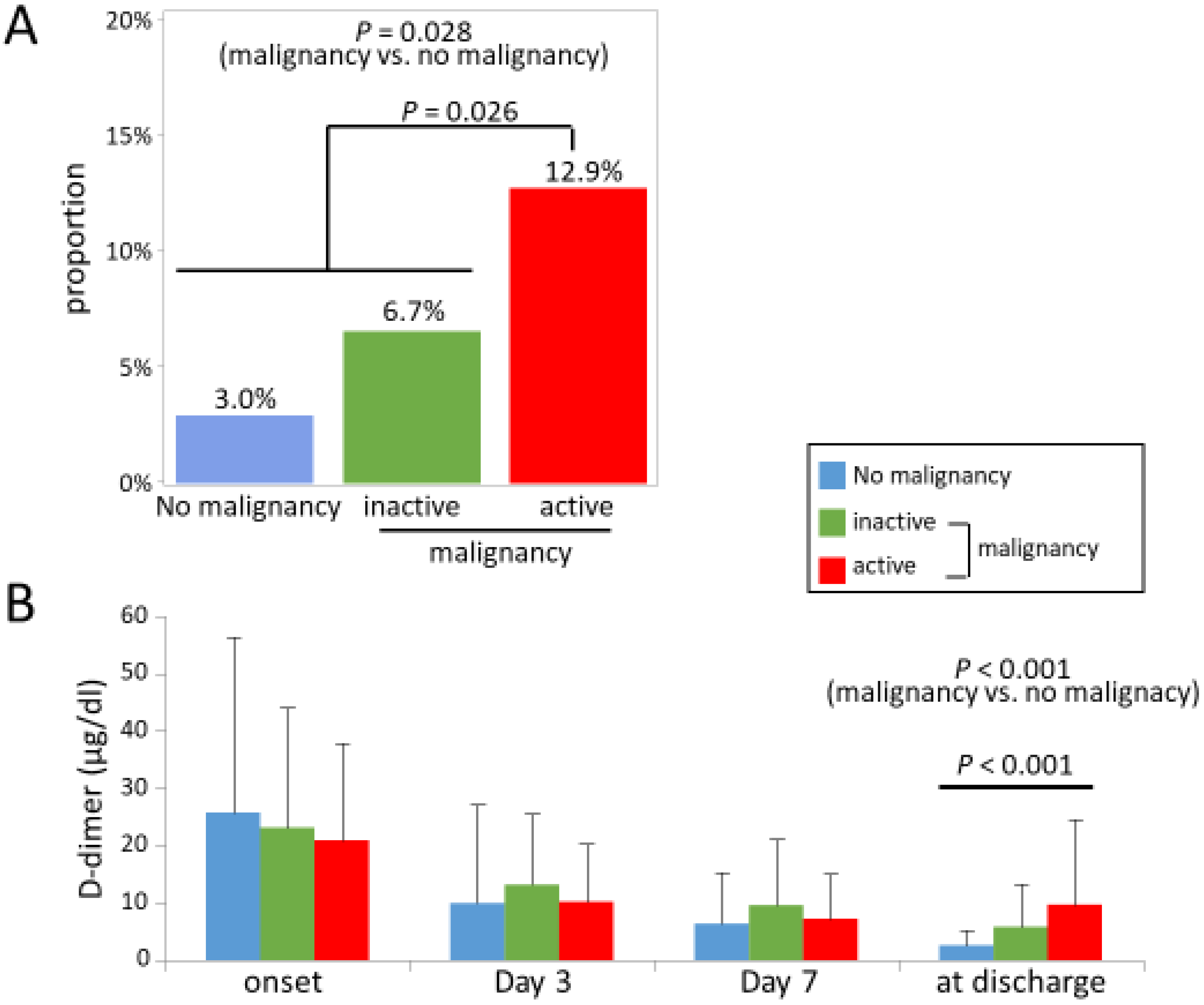
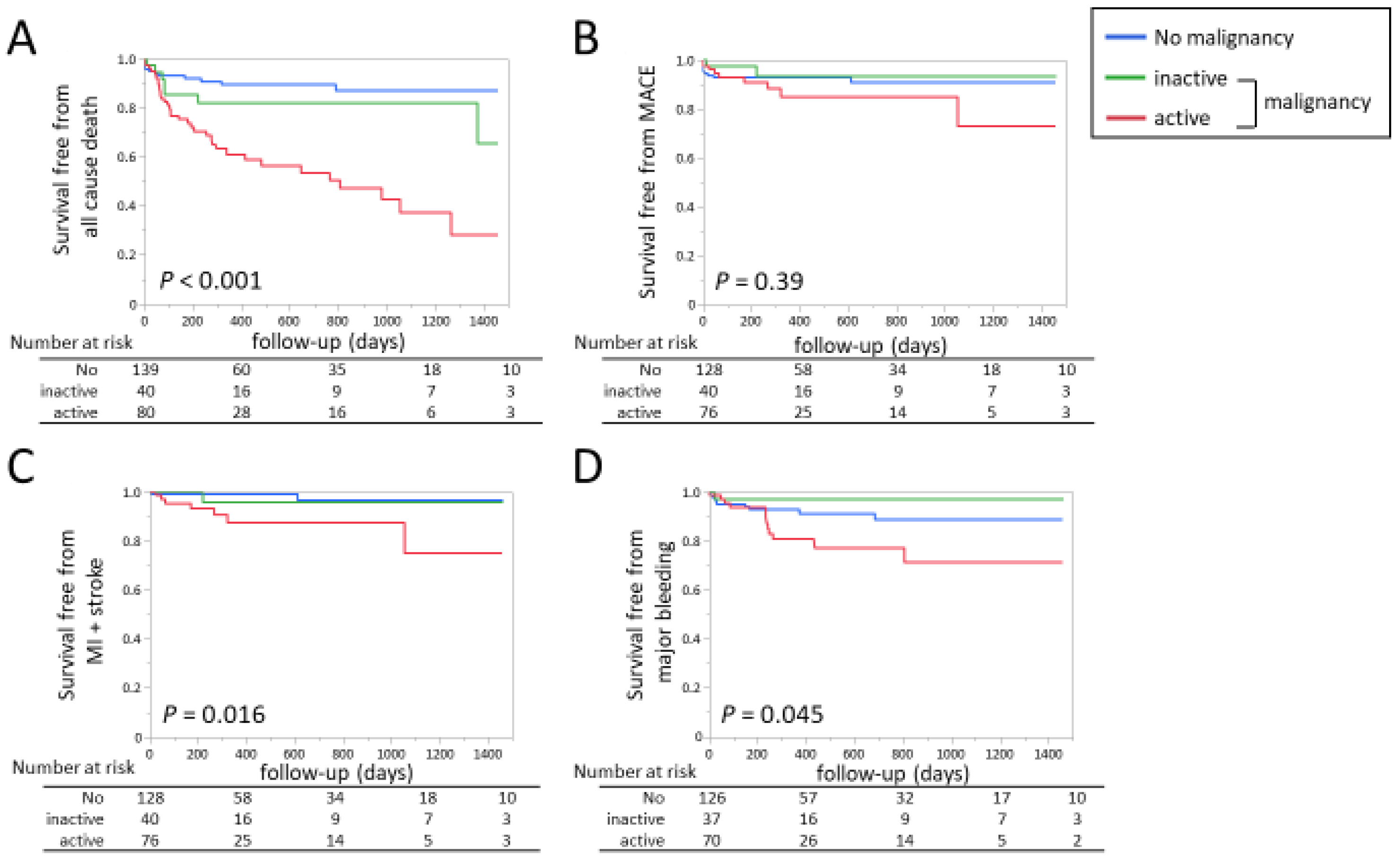
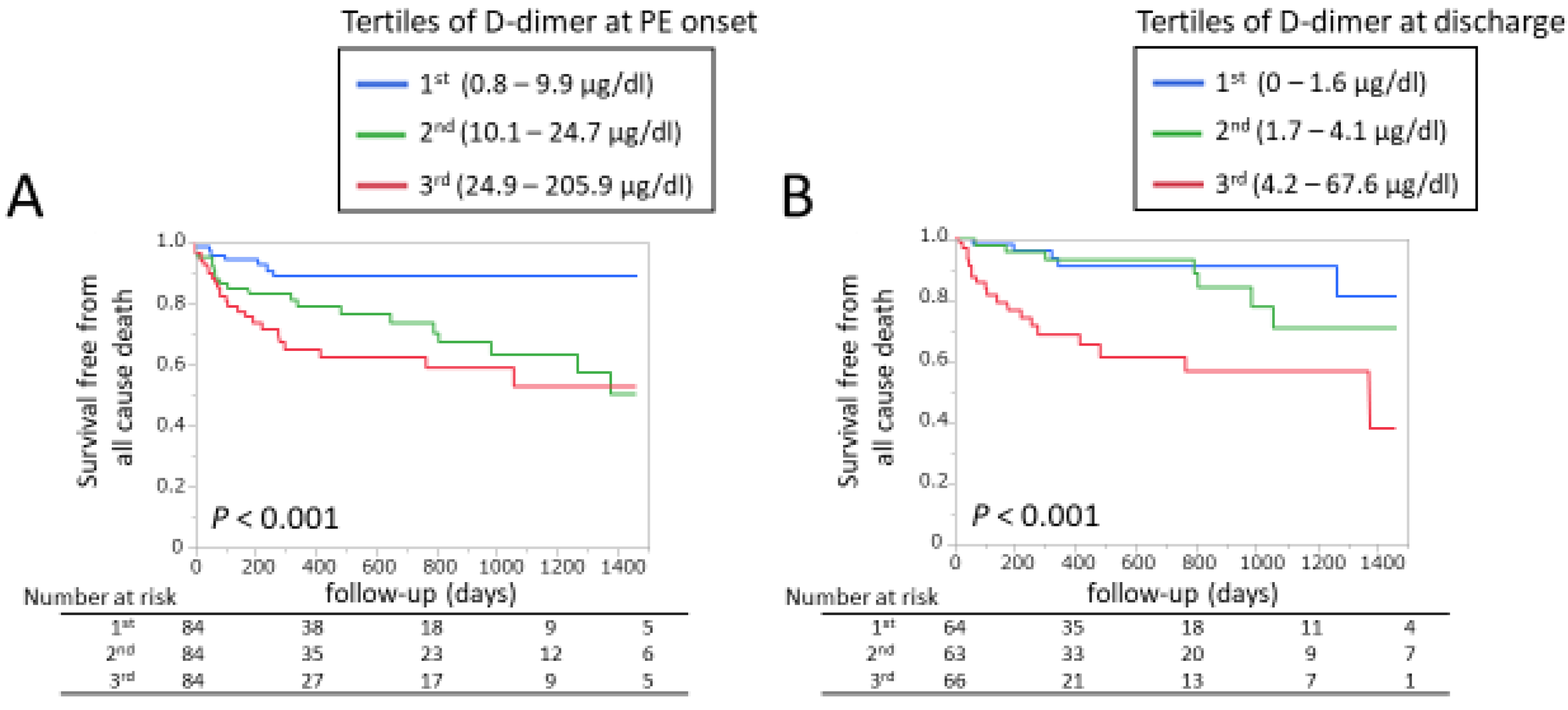
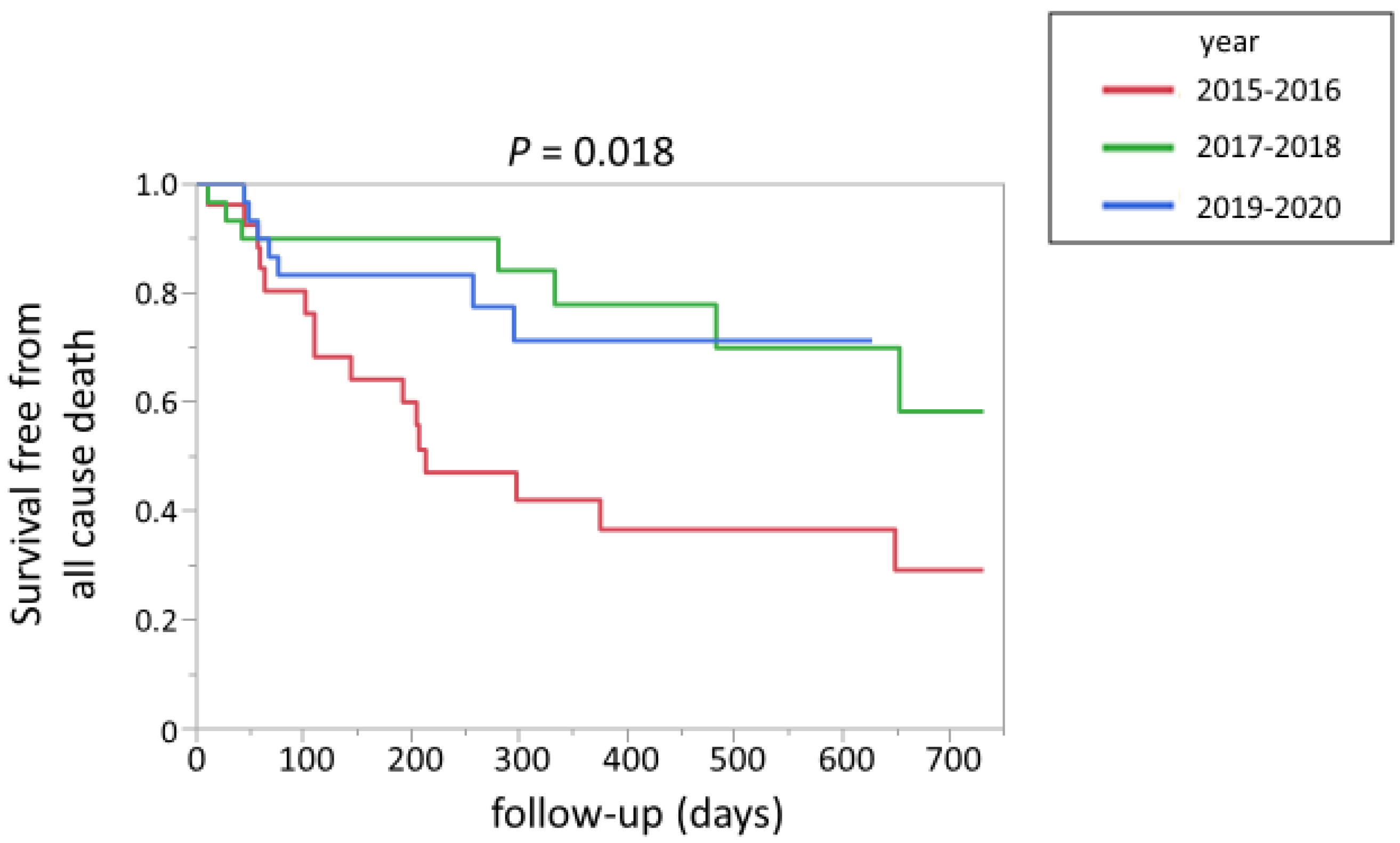
| Patients with Malignancies (N = 120) | ||
|---|---|---|
| Primary Site of Malignancy | ||
| ovary | 24 (20%) | |
| colon | 21 (17%) | |
| stomach | 12 (10%) | |
| uterus | 10 (8.3%) | |
| lung | 9 (7.5%) | |
| lymphocyte (lymphoma) | 7 (5.8%) | |
| mammary gland | 6 (5.0%) | |
| pancreas | 5 (4.2%) | |
| bladder | 4 (3.3%) | |
| prostate | 3 (2.5%) | |
| liver | 3 (2.5%) | |
| unknown | 3 (2.5%) | |
| kidney | 2 (1.6%) | |
| skin | 2 (1.6%) | |
| duodenum | 2 (1.6%) | |
| adipose tissue | 1 (0.8%) | |
| anus | 1 (0.8%) | |
| bone marrow (myeloma) | 1 (0.8%) | |
| brain | 1 (0.8%) | |
| larynx | 1 (0.8%) | |
| pharynx | 1 (0.8%) | |
| retroperitoneum | 1 (0.8%) | |
| Chemotherapy | 43 (36%) | |
| Radiation | 3 (2.5%) | |
| Malignancy | |||
|---|---|---|---|
| No (N = 139) | Yes (N = 120) | p | |
| age (years) | 62 (42–77) | 71 (61–78) | 0.001 |
| sex (male, %) | 45 (32%) | 52 (43%) | 0.069 |
| BMI | 22.7 (21.0–25.6) | 22.8 (20.0–25.2) | 0.36 |
| BSA | 1.59 (1.47–1.76) | 1.58 (1.44–1.71) | 0.36 |
| Triggers of PE | |||
| bed rest | 34 (24%) | 8 (7%) | <0.001 |
| post-operation | 25 (18%) | 18 (15%) | 0.52 |
| pregnancy | 17 (12%) | 0 (0%) | <0.001 |
| infection | 12 (9%) | 8 (7%) | 0.55 |
| collagen disease | 8 (6%) | 2 (2%) | 0.076 |
| bone fracture | 8 (6%) | 0 (0%) | 0.008 |
| congenital disease | 2 (1.4%) | 0 (0%) | 0.50 |
| drug-induced | 9 (6%) | 4 (3%) | 0.27 |
| Comorbidities/Medical history | |||
| hypertension | 51 (37%) | 42 (35%) | 0.78 |
| dyslipidemia | 24 (17%) | 15 (13%) | 0.28 |
| diabetes mellitus | 19 (14%) | 15 (13%) | 0.78 |
| hemodialysis | 1 (1%) | 0 (0%) | 1.0 |
| stroke | 11 (8%) | 8 (7%) | 0.70 |
| venous thromboembolism | 11 (8%) | 10 (8%) | 0.90 |
| arterial thromboembolism | 3 (2%) | 2 (2%) | 1.0 |
| Social history | |||
| tobacco (never/ex/current) | 97/25/17 (70%/18%/12%) | 65/33/22 (54%/28%/18%) | 0.035 |
| alcohol | 49 (35%) | 42 (35%) | 0.97 |
| Medication | |||
| antiplatelet | 8 (6%) | 6 (5%) | 0.78 |
| anticoagulant | 12 (9%) | 7 (6%) | 0.37 |
| Initial treatment | 0.59 | ||
| heparin | 111 (83%) | 96 (80%) | |
| DOAC | 20 (15%) | 21 (18%) | |
| others | 3 (2%) | 3 (3%) | |
| Treatment at discharge | <0.001 | ||
| warfarin | 39 (30%) | 5 (5%) | |
| DOAC | 79 (61%) | 91 (82%) | |
| none | 12 (9%) | 15 (13%) | |
| In-hospital death | 9 (6%) | 8 (7%) | 0.95 |
| Model 1 | Model 2 | |||||||
|---|---|---|---|---|---|---|---|---|
| β | SEM | t-Value | p Value | β | SEM | t-Value | p Value | |
| age | −0.033 | 0.051 | −0.39 | 0.70 | −0.006 | 0.050 | −0.07 | 0.95 |
| sex (female) | −0.076 | 0.80 | −0.97 | 0.33 | −0.060 | 0.79 | −0.78 | 0.44 |
| BMI | −0.019 | 0.18 | −0.24 | 0.81 | −0.018 | 0.18 | −0.24 | 0.81 |
| PE severity | ||||||||
| massive/non-massive | −0.090 | 2.27 | −0.74 | 0.46 | −0.093 | 2.25 | −0.77 | 0.44 |
| sub-massive/non-massive | 0.067 | 1.92 | 0.56 | 0.57 | 0.076 | 1.90 | 0.65 | 0.52 |
| Treatment at discharge | ||||||||
| DOACs/None | −0.053 | 1.21 | −0.71 | 0.48 | −0.022 | 1.20 | −0.30 | 0.76 |
| DOACr/None | −0.12 | 1.43 | −1.43 | 0.16 | −0.14 | 1.42 | −1.72 | 0.09 |
| Warfarin/None | 0.005 | 1.76 | 0.06 | 0.95 | −0.010 | 1.71 | −0.12 | 0.91 |
| Malignancy status | ||||||||
| malignancy (yes) | 0.32 | 0.79 | 3.95 | <0.001 | - | - | - | - |
| active malignancy (yes) | - | - | - | - | 0.35 | 0.79 | 4.51 | <0.001 |
| All Cause Death | ||||||||||||
|---|---|---|---|---|---|---|---|---|---|---|---|---|
| Model 1 | Model 2 | |||||||||||
| HR | 95% CI | p | HR | 95% CI | p | |||||||
| D-dimer at PE onset | 1.01 | 0.996–1.03 | 0.14 | |||||||||
| D-dimer at discharge | 1.06 | 1.03–1.09 | <0.001 | |||||||||
| Anticoagulation therapy at discharge | ||||||||||||
| DOACs/None | 0.31 | 0.11–0.88 | 0.028 | 0.11 | 0.027–0.46 | 0.003 | ||||||
| DOACr/None | 0.19 | 0.063–0.55 | 0.002 | 0.081 | 0.017–0.39 | 0.002 | ||||||
| Warfarin/None | 0.61 | 0.15–2.47 | 0.49 | 0.16 | 0.027–0.99 | 0.049 | ||||||
| Malignancy status | ||||||||||||
| (active/no) | 23.8 | 6.79–83.6 | <0.001 | 9.32 | 2.50–34.7 | <0.001 | ||||||
| (active/inactive) | 5.30 | 1.92–14.6 | 0.001 | 4.17 | 1.16–15.0 | 0.028 | ||||||
| MACE | MI + Stroke | Major Bleeding | ||||||||||
| HR | 95% CI | p | HR | 95% CI | p | HR | 95% CI | p | ||||
| Anticoagulation therapy at discharge | ||||||||||||
| DOACs/None | 0.15 | 0.030–0.72 | 0.018 | 0.48 | 0.051–4.54 | 0.52 | 0.44 | 0.12–1.66 | 0.23 | |||
| DOACr/None | 0.025 | 0.003–0.19 | <0.001 | 0.086 | 0.006–1.18 | 0.066 | 0.18 | 0.040–0.82 | 0.027 | |||
| Warfarin/None | 0.074 | 0.006–0.89 | 0.041 | 0.27 | 0.015–5.10 | 0.38 | 1.02 | 0.25–4.21 | 0.98 | |||
| Malignancy status | ||||||||||||
| (active/no) | 17.0 | 3.09–93.7 | 0.001 | 9.52 | 1.72–52.6 | 0.010 | 3.39 | 1.34–8.60 | 0.010 | |||
| (active/inactive) | 8.05 | 0.95–68.1 | 0.056 | 4.89 | 0.56–42.8 | 0.15 | 8.15 | 1.04–63.8 | 0.046 | |||
| Malignancy Status | |||||||||
|---|---|---|---|---|---|---|---|---|---|
| No | Inactive | Active | |||||||
| HR | 95% CI | p | HR | 95% CI | p | HR | 95% CI | p | |
| D-dimer at discharge | 0.63 | 0.21–1.19 | 0.20 | 1.67 | 1.18–3.74 | <0.001 | 1.05 | 1.03–1.08 | <0.001 |
Disclaimer/Publisher’s Note: The statements, opinions and data contained in all publications are solely those of the individual author(s) and contributor(s) and not of MDPI and/or the editor(s). MDPI and/or the editor(s) disclaim responsibility for any injury to people or property resulting from any ideas, methods, instructions or products referred to in the content. |
© 2023 by the authors. Licensee MDPI, Basel, Switzerland. This article is an open access article distributed under the terms and conditions of the Creative Commons Attribution (CC BY) license (https://creativecommons.org/licenses/by/4.0/).
Share and Cite
Himeno, M.; Nagatomo, Y.; Miyauchi, A.; Sakamoto, A.; Kiyose, K.; Yukino-Iwashita, M.; Kawai, A.; Naganuma, T.; Maekawara, S.; Naito, A.; et al. D-Dimer beyond Diagnosis of Pulmonary Embolism: Its Implication for Long-Term Prognosis in Cardio-Oncology Era. J. Pers. Med. 2023, 13, 226. https://doi.org/10.3390/jpm13020226
Himeno M, Nagatomo Y, Miyauchi A, Sakamoto A, Kiyose K, Yukino-Iwashita M, Kawai A, Naganuma T, Maekawara S, Naito A, et al. D-Dimer beyond Diagnosis of Pulmonary Embolism: Its Implication for Long-Term Prognosis in Cardio-Oncology Era. Journal of Personalized Medicine. 2023; 13(2):226. https://doi.org/10.3390/jpm13020226
Chicago/Turabian StyleHimeno, Masafumi, Yuji Nagatomo, Akira Miyauchi, Aimi Sakamoto, Keita Kiyose, Midori Yukino-Iwashita, Akane Kawai, Tsukasa Naganuma, Satonori Maekawara, Ayami Naito, and et al. 2023. "D-Dimer beyond Diagnosis of Pulmonary Embolism: Its Implication for Long-Term Prognosis in Cardio-Oncology Era" Journal of Personalized Medicine 13, no. 2: 226. https://doi.org/10.3390/jpm13020226
APA StyleHimeno, M., Nagatomo, Y., Miyauchi, A., Sakamoto, A., Kiyose, K., Yukino-Iwashita, M., Kawai, A., Naganuma, T., Maekawara, S., Naito, A., Kagami, K., Yumita, Y., Yasuda, R., Toya, T., Ikegami, Y., Masaki, N., & Adachi, T. (2023). D-Dimer beyond Diagnosis of Pulmonary Embolism: Its Implication for Long-Term Prognosis in Cardio-Oncology Era. Journal of Personalized Medicine, 13(2), 226. https://doi.org/10.3390/jpm13020226







